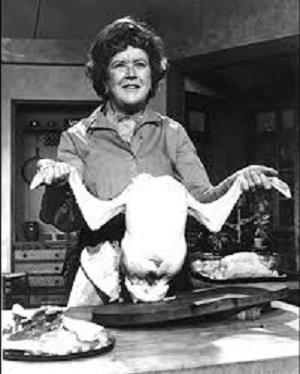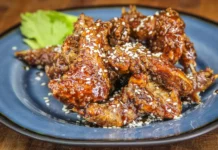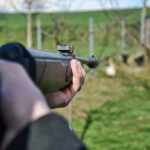One of my blogger friends once reminded me that blogging should be about sharing, not showing off. I try to follow her advice, but I’m afraid that this post might be edging over a little into showing off. I recently saw the film Julie and Julia again on TV – I really like this movie; perhaps it’s because of the nostalgia created by the movie sets of an old Paris, perhaps because it has Meryl Streep in it.
Anyway, I noticed that the last dish that ‘Julie’ had to make was a fully boned duck, stuffed and baked in a fancy pastry crust – Pâté de Canard en Croûte. This dish was a major achievement for her – not only it was the last of the 365 dishes she had to create over the year, but she had to overcome the hurdle of preparing a complicated dish.
I, too, then decided to leap to the challenge of making Canard en Croûte. At first, I thought this dish might be too ‘fiddly’, but then again it would be good practice for me- in three months I’m off again to Le Cordon Bleu school in Paris to do the advanced cuisine course! Was this dish worth it? Was it worth the many hours spent in the kitchen and dropping my knife several times on my foot? Read to the end of this post and see!
(P.S. If you enjoyed this post, please do ‘like’ my G’day Souffle’ Facebook page!)
The first steps to making the dish involve removing all the bones of the duck, leaving the skin in tact. It’s important to start with a positive ‘can-do’ attitude- remember that you are master of the duck!
To bone the duck, start with the back of the duck facing upwards. First you cut a deep slit down one side of the backbone (going from neck to tail), pulling the flesh away from the carcass using your fingers.
As your knife reaches the ball joint of the thigh, you find that you’ve hit a roadblock. You now need to sever or ‘snap’ the joint using your fingers and you can now slice to the end of the backbone.
Now repeat this process on the other side of the back bone. You will now see a fully exposed back bone with the ribs attached- cut away this part of the carcass to tidy things up and make it more manageable to handle the remaining carcass. Next you cut very close to the ridge of the breastbone to free the carcass, being careful not to cut the skin. Once the carcass is fully released, you’re not done yet! There are still the bones to remove from the wings and thighs. To remove the bone from the thighs, scrape the meat from the bone going from the ball joint to the tip of the thigh. Repeat with the wings.
At some point, Julia warns us that the whole duck carcass with dangling legs, etc will appear to be an unrecognizable mass of confusion and therefore we should not be overcome with fright. Several times, I had to remind myself to put on my ‘Julia hat’ and fill myself with confidence. Yes, I can bone six ducks if I wanted to!  After boning the duck, you are left with an empty ‘duck suit,’ ready to be stuffed, then rolled and stitched up into a loaf shape.
After boning the duck, you are left with an empty ‘duck suit,’ ready to be stuffed, then rolled and stitched up into a loaf shape.
Next, you brown the duck in oil on the stovetop. Prepare a chilled pastry dough and roll 2/3 of it out into an oval shape (1/8 inches thick). Place the browned duck on top of the dough with the breast side facing up and bring the pastry up around the duck, patting it into place.
Roll out the remaining pastry into an oval shape and place it on top of the duck. Brush pastry top with egg wash. Cut out small pastry decorations using a cookie cutter, using back of knife to press fan-shaped lines into them. Coat them also with the egg wash. Bake for 1.5 to 2 hours at 350 F (180 C). Julia recommends serving the dish chilled, but you can also serve it hot.  Before serving, you’ll need to lift the top crust off and remove the duck, to cut all of the trussings. Place the duck back into the pastry to serve.
Before serving, you’ll need to lift the top crust off and remove the duck, to cut all of the trussings. Place the duck back into the pastry to serve.
But was it worth it? Julia Child gave people the confidence to toss out their TV dinners and to get into the kitchen to cook- even complicated things like Pâté de Canard en Croûte. I accepted the challenge and happily succeeded! This dish is indeed an impressive sight when you bring it to the dinner table! So, yes, it was worth it. But bones are what give meat dishes their juicy flavor – so why remove them? And there are other duck dishes that are more delicious and simpler to prepare (see my Duck Breast in Orange Sauce). So, yes, with this dish Canard en Croûte, I admit I was showing off a bit, but probably I won’t be doing it again! It will be back to my ‘blogging is sharing’ once more.















































